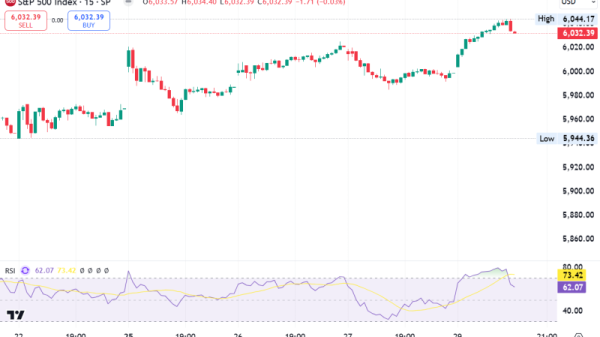The Federal Reserve is having its last meeting of the year on the 17th of December.
The market is now expecting another rate cut, but with economic growth outperforming expectations and inflation showing signs of resistance, the Fed may reconsider its decision.
The US economy has been exceptional, but with geopolitical uncertainty along with the elected president heading to office soon, Fed officials might be hesitant. Should we expect a cut or will the Fed decide to pause?
Economic growth defies expectations
The Atlanta Fed’s GDPNow model has projected Q4 growth at 3.2%, up from 2.8% in Q3 and 3.0% in Q2.
These figures are proving that the US economy has been robust, thanks to a surge in service sector activity.
S&P Global’s Flash November PMI data noted the fastest rise in service sector output since March 2022.
New orders in this sector also remain strong, indicating continued momentum into year-end.
Such resilience contrasts with Federal Reserve actions to ease financial conditions.
After two consecutive rate cuts totaling 75 basis points, many expect a further 25-basis-point reduction in December.
The CME FedWatch Tool suggests a 74% probability for this move.
Yet, persistent economic strength may cause the Fed to pause.
Inflation progress slows
Inflation, a key focus for policymakers, is no longer falling as consistently as earlier this year.
October’s Consumer Price Index (CPI) and Personal Consumption Expenditures (PCE) Index showed signs of stabilization rather than decline.
Federal Reserve Governor Christopher Waller likened the situation to an MMA fight, where inflation “keeps slipping out of grasp.”
The Fed has made significant progress, but the work is clearly not over.
Core inflation, excluding volatile housing, food, and energy prices, is roughly consistent with 2002-2007 levels, according to New York Fed President John Williams.
Housing costs, which have inflated the CPI, are expected to ease as fresher data updates government reports.
However, risks of inflation staying above the Fed’s 2% target persist.
Upcoming data may surprise
This week’s economic releases could reshape the Fed’s approach. November’s ADP Employment Change Report and ISM Services PMI data are due shortly, followed by Friday’s nonfarm payrolls.
Early expectations suggest 200,000 jobs were added in November, but October’s figures were distorted by hurricane and strike disruptions.
If the data confirms economic acceleration, GDP expectations may rise further, increasing pressure on the Fed to hold rates steady.
Fed Chair Jerome Powell’s comments on Wednesday night will likely provide more clarity. Powell’s last public statements were less dovish than anticipated, and another strong data set could reinforce this tone.
Gold’s decline reflects market uncertainty
The gold market has mirrored the uncertainty surrounding the Fed’s next move. Prices fell 0.6% Monday, breaking a four-day rally, as the US dollar strengthened.
Spot gold settled near $2,640 per ounce after climbing earlier this year to a record high in late October.
The dollar’s rally, partly driven by President-elect Donald Trump’s aggressive comments on BRICS nations seeking alternatives to the dollar, has weighed on gold.
Trump’s threats of 100% tariffs on BRICS nations, should they develop a common currency, have stoked fears of prolonged US economic dominance.
Despite the recent decline, gold remains 28% higher year-to-date, supported by central bank purchases and geopolitical uncertainty.
Analysts predict volatile trading heading into year-end as markets adjust to shifting Fed expectations.
Geopolitical moves pressure the dollar
President-elect Trump’s comments have reignited discussions on de-dollarization. Trump warned BRICS nations—including Brazil, Russia, India, China, and South Africa—against seeking alternatives to the U.S. dollar, threatening them with 100% tariffs.
Economists largely dismiss the feasibility of a BRICS common currency, citing internal divisions and practical hurdles like differing monetary policies.
However, the effort to reduce reliance on the dollar reflects broader frustrations with its dominance in global trade and finance.
According to the IMF, the dollar still accounts for 58% of global currency reserves and is involved in 88% of foreign exchange transactions.
Yet, incremental changes are underway.
The Chinese yuan, while only 2% of global reserves, is gaining traction, and central banks have diversified reserves into gold and other currencies.
The market’s hopes remain high
The stock market’s recent performance highlights the tension between optimism and risk.
The S&P 500 and Nasdaq Composite have rallied significantly since October, with both indices nearing overbought levels.
Indicators like the Citibank Panic/Euphoria model and the Fear & Greed Index suggest elevated investor confidence.
This confidence hinges on continued rate cuts. If upcoming data or Powell’s comments point to a pause, markets could face disappointment.
A hawkish shift could disrupt the current rally, but as long as the economy remains resilient, and consumer confidence high, the market could continue breaking all-time highs.
The post Is the US economy too strong for a rate cut? appeared first on Invezz
































